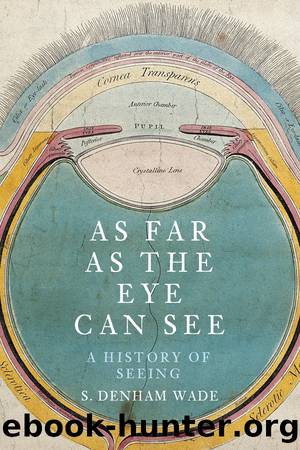As Far as the Eye can See by S. Denham Wade

Author:S. Denham Wade
Language: eng
Format: epub
Publisher: The History Press
The Hague, 1608
In September 1608, a Dutch spectacle-maker from Middleburg travelled to The Hague carrying a letter from local officials recommending him to Prince Maurice, the commander-in-chief of the Dutch forces. Maurice was conducting a peace conference with representatives of the Dutch Republic’s long-term enemies, Spain and France. The letter informed the prince that the bearer, Hans Lipperhey, claimed to have invented an apparatus for ‘seeing remote objects as if they were near’. The device was an enclosed tube with a larger convex lens (the objective) at one end and a smaller concave lens at the other. If it worked as promised it could be a valuable military instrument.
The prince was impressed, and proudly demonstrated the discovery to the French and Spanish envoys. He paid Lipperhey a generous sum to produce several more telescopes exclusively for him. A week later, Lipperhey submitted a patent application. The patent office was less forthcoming than the prince and refused Lipperhey a patent on the grounds that the device was too easily copied to be patentable.
Unfortunately for Lipperhey, the patent office was proved correct almost immediately. Tales of the telescope spread around Europe, as the Spanish and French commanders promptly reported back to their respective courts.28 The ruler of the Spanish Netherlands got hold of an instrument and managed to copy it. He sent one to a cardinal in Rome,29 while the French ambassador dispatched a soldier to Paris with instructions on how to copy the device for the king there. Claims of prior invention emerged and carried on for years.30
Others may well have come up with the same idea before Lipperhey – it was after all a fairly simple one and could have been arrived at by accident while playing around with lenses many times over. But it is now generally agreed that, in taking it into the public arena, Lipperhey was the first to recognise the telescope’s potential as something more than a curiosity, even if he wasn’t the first person to make one.
In any case, beyond the honour and glory of being the telescope’s inventor, by late 1608 it was obvious there was no hope of Lipperhey gaining any exclusivity or privilege in making it. Telescopes could be bought in Paris by April the following year, in Milan by May, and Venice and Naples by the summer.31
Notwithstanding this flurry of interest, many people found the first telescopes disappointing to look through. They were made with spectacle lenses and only magnified about three times. Their field of vision was very narrow, making them difficult to use. The images were considerably worse than you would see through the cheapest telescope available today. They fell considerably short of the possibilities that had been dreamt of by optics scholars for centuries. Four hundred years earlier, Roger Bacon speculated on the possibilities of lenses to ‘cause the sun, moon and stars in appearance to descend here below’ and allow men to ‘read the smallest letters and number grains of dust and sand’ from a great distance.32
Download
This site does not store any files on its server. We only index and link to content provided by other sites. Please contact the content providers to delete copyright contents if any and email us, we'll remove relevant links or contents immediately.
Sapiens: A Brief History of Humankind by Yuval Noah Harari(13053)
Sapiens by Yuval Noah Harari(4537)
Homo Deus: A Brief History of Tomorrow by Yuval Noah Harari(4279)
Pale Blue Dot by Carl Sagan(4001)
Origin Story: A Big History of Everything by David Christian(3139)
Livewired by David Eagleman(3122)
Brief Answers to the Big Questions by Stephen Hawking(2878)
Inferior by Angela Saini(2831)
Origin Story by David Christian(2683)
The Evolution of Beauty by Richard O. Prum(2553)
Signature in the Cell: DNA and the Evidence for Intelligent Design by Stephen C. Meyer(2501)
The Gene: An Intimate History by Siddhartha Mukherjee(2491)
Aliens by Jim Al-Khalili(2382)
How The Mind Works by Steven Pinker(2213)
Sex at Dawn: The Prehistoric Origins of Modern Sexuality by Ryan Christopher(2150)
From Bacteria to Bach and Back by Daniel C. Dennett(2148)
A Short History of Nearly Everything by Bryson Bill(2135)
Endless Forms Most Beautiful by Sean B. Carroll(2083)
Who We Are and How We Got Here by David Reich(2059)
